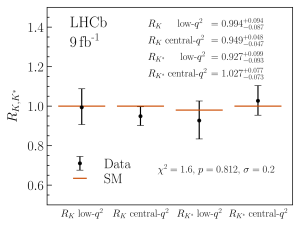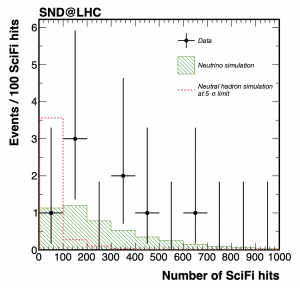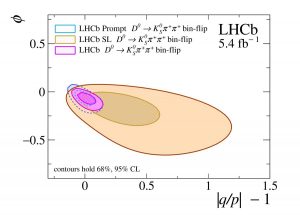With the year 2023 approaching its end, we summarise the prominent milestones achieved by the LPHE research teams throughout this year.
Physics results
Several important physics results have been released, with active contribution of the LPHE researchers. These include:
Lepton universality holds strong
The LHCb collaboration has performed the most precise to date test of lepton flavour universality in rare decays of b-quarks to s-quarks and two charged leptons. The new results are consistent with the Standard Model expectations. Previously seen deviations in past measurements were understood to originate from unaccounted background sources. For more details, see the papers:
Neutrinos from the LHC
The direct observation of muon neutrinos is performed through their interactions with the SND@LHC detector: 8 neutrino candidates are identified on top of negligible background. Those are produced in proton-proton collisions at the LHC, cross the massive shielding material, and produce a muon track when interacting inside the detector.
For more details, see the paper:
Weighing the beauty baryons
The LHCb collaboration has performed the world-best measurement of the mass of the Ω−b (Omega-b) baryon. It has the quark content (b s s) and does not contain any quarks of the first generation, making it very rare: only a few hundred Ω−b baryon decays are available for study at LHCb, and this is already the world’s largest dataset of these baryons.
m(Ω−b)=6045.9±0.5(stat)±0.6(syst) MeV
For more details, see the paper:
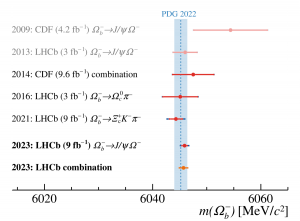
Beta-spectroscopy of Thulium-171
The spectrum of electrons produced in the beta-decay of Thulium-171 to Ytterbium-171 was measured for the first time. This isotope is potentially interesting as a target material for future cosmological measurements. The endpoint of the beta-decay spectrum was measured with the Kurie plot technique.
Remarkably, the EPFL students have opportunity to perform their practical work on the very same setup used for this measurement.
For more details, see the publication:
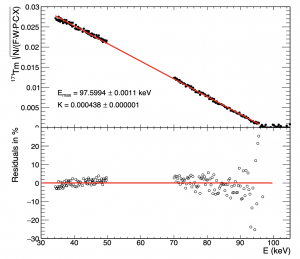
Dark photons
Since 2023, the LPHE group is also active in the NA62 experiment, and the first results with our contribution are already available!
The NA62 experiment searched for hypothetical particles – “dark photons” – that would be produced in the interactions of the proton beam with the target, and decay into an electron-positron pair. No signal of new particles was observed, but a new part of the allowed parameter space has been excluded.
For more details, see the preprint.
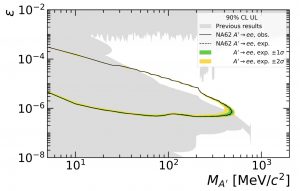
Charming news
The LHCb collaboration searched for rare decays of D0 mesons into two muons. In the Standard model, this decay is expected to happen less than once in 10^12 D0-meson decays. Our sensitivity is not yet reaching this level: LHCb has set an upper limit of the rate of this decay at the 10^(-9) level, which is the world best constraint on this process.
See the publication:
For the same D0 meson, LHCb has measured the mixing and CP violation parameters. This probes transitions (‘oscillations’) of D0 mesons into their antiparticles, as well as difference in properties of D0 and anti-D0 mesons. This time, we tagged the flavour of the D0 (anti-D0) mesons by their production in B-meson decays. The results are consistent with the previous LHCb measurement that relied on the promptly-produced D mesons.
For more details, see the publication:
Other publications
These documents describe the details on construction of the detectors (both currently operating and planned), with contributions from the detector experts in our lab.
- SND@LHC: The Scattering and Neutrino Detector at the LHC
- The LHCb upgrade I
- The Forward Physics Facility at the High-Luminosity LHC
Our team members have also contributed to the HFLAV report, which provides averages of measured properties of heavy-quark hadrons and heavy leptons.
In other news
- Since early 2023, we have a new tenure-track assistant professor Radoslav Marchevski. He, together with the members of his team, do not only contribute to our activities with the LHCb experiment, but also initiated the contribution to the kaon experiments: ongoing NA62 and planned HIKE.
- Also in 2023, Fred Blanc obtained the title of adjunct professor. Congratulations to the new professors!
- Lesya Shchutska obtained a prestigious Swiss Science Prize Latsis “for paving the way to the discovery of new particles”.
- We had four excellent PhD students graduating from our group: Carina Trippl, Sara Celani, Veronica Kirsebom, and Serhii Cholak. All of them continued their scientific journey with the postdoctoral positions abroad. Notably, Carina has received the SNSF Postdoc.Mobility fellowship to support her work in Barcelona, while Veronica obtained her SNSF Postdoc.Mobility funding to work in Milano.
- Our former PhD student Guillaume Pietrzyk has already obtained four prizes for his PhD thesis: the CHIPP prize; LHCb collaboration prize; EDPY distinction; and Gilbert Hausmann Award.
- Six master students have completed their research projects with us this year.
- Two LPHE/IPHYS technicians, Rodolphe Gonzalez and Norbert Adjadj, were rewarded by the LHCb collaboration prizes for their contributions to the construction of the scintillating-fiber tracking detector.
